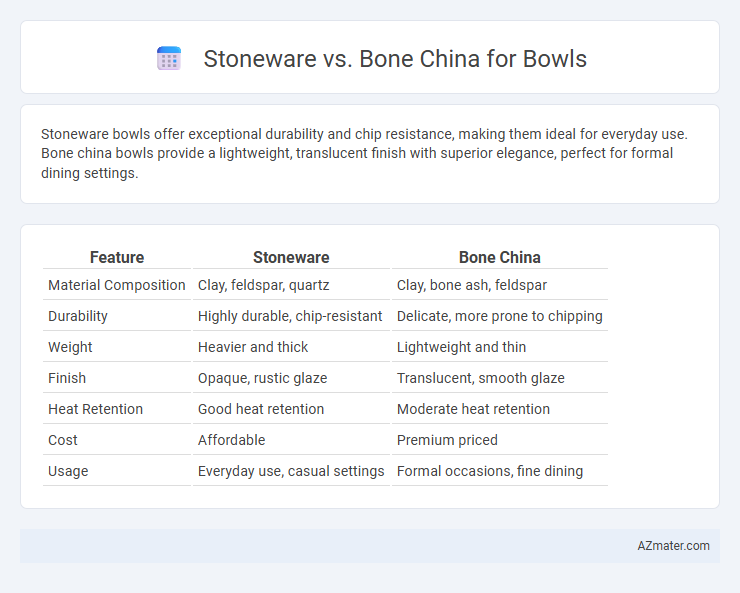Stoneware bowls offer exceptional durability and chip resistance, making them ideal for everyday use. Bone china bowls provide a lightweight, translucent finish with superior elegance, perfect for formal dining settings.
Table of Comparison
| Feature | Stoneware | Bone China |
|---|---|---|
| Material Composition | Clay, feldspar, quartz | Clay, bone ash, feldspar |
| Durability | Highly durable, chip-resistant | Delicate, more prone to chipping |
| Weight | Heavier and thick | Lightweight and thin |
| Finish | Opaque, rustic glaze | Translucent, smooth glaze |
| Heat Retention | Good heat retention | Moderate heat retention |
| Cost | Affordable | Premium priced |
| Usage | Everyday use, casual settings | Formal occasions, fine dining |
Introduction to Stoneware and Bone China
Stoneware offers durability and a rustic appeal with its dense, non-porous composition fired at high temperatures, making it resistant to chips and scratches. Bone china is prized for its elegant translucency and lightweight feel, crafted from a blend of bone ash, feldspar, and kaolin, which enhances strength while maintaining a delicate appearance. Both materials present unique advantages: stoneware's robustness suits everyday use, while bone china's refined finish is ideal for formal dining settings.
Material Composition Differences
Stoneware bowls are made from dense, non-porous clay fired at high temperatures between 1,100degC and 1,300degC, resulting in a durable, chip-resistant surface ideal for everyday use. Bone china bowls incorporate bone ash along with kaolin and feldspar, fired at lower temperatures around 1,200degC, producing a translucent, lightweight, and highly refined ceramic prized for its elegance. The key material difference lies in bone china's use of bone ash, which enhances whiteness and strength, whereas stoneware's dense clay composition offers superior toughness and heat retention.
Durability and Strength Comparison
Stoneware bowls exhibit exceptional durability due to their dense, non-porous composition, making them resistant to chipping and cracking under heavy use. Bone china bowls, while renowned for their elegant translucency and lightness, possess impressive strength derived from bone ash content, providing a high fracture toughness despite their delicate appearance. When comparing durability, stoneware offers superior resistance to daily wear and thermal shock, whereas bone china balances strength with refined aesthetics suited for more careful handling.
Appearance and Aesthetic Appeal
Stoneware bowls exhibit a rustic, earthy appearance with a matte or slightly textured finish, often showcasing natural variations in color and glaze that enhance their artisanal charm. Bone china bowls are renowned for their delicate translucency, smooth, glossy surface, and elegant whiteness, lending a refined and sophisticated aesthetic ideal for formal settings. The choice between stoneware and bone china for bowls significantly impacts the visual appeal, with stoneware emphasizing a sturdy, handcrafted look and bone china offering a sleek, luxury presentation.
Weight and Handling
Stoneware bowls tend to be heavier and more robust due to their dense, vitrified clay composition, offering durability and a substantial feel in hand which suits everyday use. Bone china bowls are lighter and more delicate, crafted with bone ash that enhances translucency and strength while providing a refined, comfortable grip. The weight difference impacts handling; stoneware offers stability, whereas bone china allows for easier maneuverability and a more elegant dining experience.
Heat Retention and Microwave Safety
Stoneware bowls exhibit excellent heat retention due to their dense, stone-based composition, ensuring food stays warm longer compared to Bone China. In terms of microwave safety, both stoneware and bone china are generally microwave-safe, but stoneware's robust structure typically withstands rapid temperature changes better without cracking. Bone china, while elegant and lightweight, may require careful handling to avoid thermal shock in microwave use.
Suitability for Everyday Use
Stoneware bowls offer exceptional durability and resistance to chipping, making them highly suitable for everyday use in busy kitchens. Bone china bowls, while elegant and lightweight, tend to be more fragile and require careful handling, limiting their practicality for daily meals. Stoneware's sturdy composition withstands frequent microwave and dishwasher cycles, enhancing convenience for regular dining routines.
Price and Value Considerations
Stoneware bowls generally offer a more affordable price point compared to bone china, making them an attractive option for everyday use and casual dining. Bone china is valued for its delicate translucency and superior strength, often commanding a higher price due to its premium materials and craftsmanship. When considering value, stoneware provides durability and resistance to chipping, while bone china offers elegance and a lightweight feel, which may justify its cost for formal settings or special occasions.
Maintenance and Care Requirements
Stoneware bowls require regular handwashing with mild detergent to prevent glaze damage and avoid dishwasher use for long-term durability, while bone china bowls are more delicate, necessitating gentle cleaning and avoidance of abrasive materials to maintain their fine translucent quality. Both materials benefit from avoiding sudden temperature changes to prevent cracking, but bone china demands extra care due to its thinner structure and higher fragility. Proper storage with padding or separators helps preserve the integrity and appearance of both stoneware and bone china bowls over time.
Environmental Impact and Sustainability
Stoneware bowls are generally more environmentally friendly due to their natural clay composition and lower energy consumption during firing compared to bone china, which requires animal bone ash and higher kiln temperatures. Bone china production involves ethical concerns related to bone sourcing and typically results in higher carbon emissions, affecting sustainability. Choosing stoneware supports reduced ecological footprints and promotes the use of abundant, plant-based raw materials in ceramic manufacturing.

Infographic: Stoneware vs Bone China for Bowl
 azmater.com
azmater.com